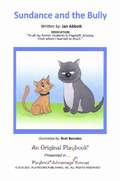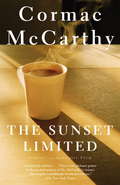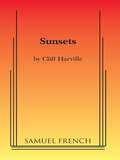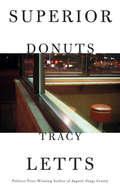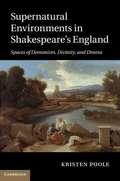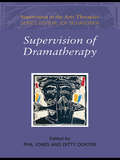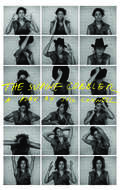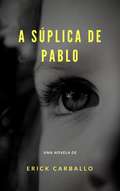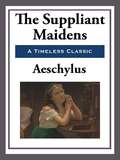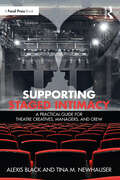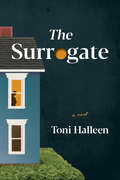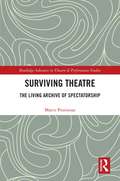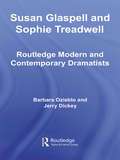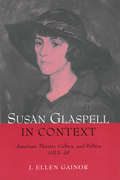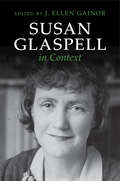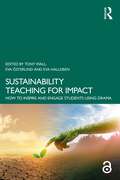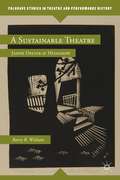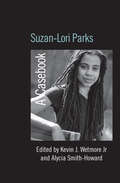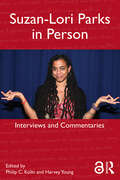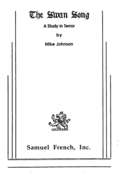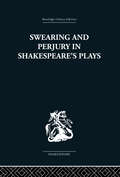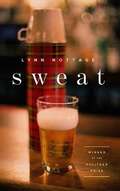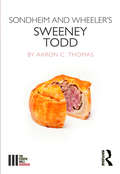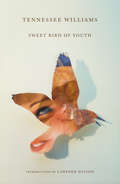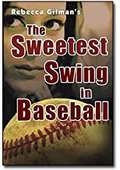- Table View
- List View
Sundance and the Bully
by Jan AbbottWelcome to the world of Playbooks® and the beginning of a wonderful role-play reading adventure! Playbooks® stories are presented in a unique and colorful format and are read out loud by several readers like a play, without memorization, props, or a stage. <p><p>When you read a Playbook®, you and other readers bring the story to life and become the characters. As you read your part out loud, you will have fun expressing and acting like your character. You and the other readers will explore the story plot together and learn what will happen next. It's an exciting journey of discovery that pulls you into the story, and you'll want to read it out loud again and again!
The Sunset Limited: A Novel in Dramatic Form (Vintage International)
by Cormac MccarthyA startling encounter on a New York subway platform leads two strangers to a run-down tenement where a life or death decision must be made.In that small apartment, "Black" and "White," as the two men are known, begin a conversation that leads each back through his own history, mining the origins of two fundamentally opposing world views. White is a professor whose seemingly enviable existence of relative ease has left him nonetheless in despair. Black, an ex-con and ex-addict, is the more hopeful of the men-though he is just as desperate to convince White of the power of faith as White is desperate to deny it. Their aim is no less than this: to discover the meaning of life.Deft, spare, and full of artful tension, The Sunset Limited is a beautifully crafted, consistently thought-provoking, and deceptively intimate work by one of the most insightful writers of our time.
Sunsets
by Cliff HarvilleThis collection consists of four short plays: George L. Smith (Monologue / 1m), A Silent Catastrophe (One Act / 1m, 1f / Interior), Sara Hubbard (Monologue / 1f), and Hang Me My Afghan (One Act / 1m, 1f / Interior)
Superior Donuts
by Tracy Letts"It is a meditation on Chicago's old soul . . . a witty, seductive, live-wire and greatly entertaining dark comedy that you just don't want to end." -Chicago Tribune"The sting, the speed and marksmanship of the gimcracks his characters fire at each other . . . drips the kind of soulful, energized sarcasm that has long characterized [Letts'] work as an actor and playwright."-Time Out Chicago Tracy Letts, who won the 2008 Pulitzer Prize for his epic, caustic Oklahoma family drama August: Osage County, has shifted gears with this entertaining comedy set in a donut shop. A love letter to the city where he has lived for more than twenty years, Letts describes his new work as "an exploration of the Chicago storefront experience." The play takes place in the north side neighborhood of Uptown, where Arthur Przybyszewski runs the donut shop that has been in his family for sixty years. More content to spend the day smoking weed and reminiscing about his Polish immigrant father, Arthur hires a shop assistant, the young African American Franco Wicks, who has both an unpublished novel and unpaid gambling debt. Superior Donuts premiered at Steppenwolf Theatre Company and recently opened on Broadway--following the same path of success as Letts' previous work.Tracy Letts is the author of Killer Joe, Bug, Man from Nebraska (nominated for the 2004 Pulitzer Prize), and August: Osage County (awarded the 2008 Pulitzer Prize for Drama). He is a member of Chicago's Steppenwolf Theatre Company.
Supernatural Environments in Shakespeare's England: Spaces of Demonism, Divinity, and Drama
by Kristen PooleBringing together recent scholarship on religion and the spatial imagination, Kristen Poole examines how changing religious beliefs and transforming conceptions of space were mutually informative in the decades around 1600. Supernatural Environments in Shakespeare's England explores a series of cultural spaces that focused attention on interactions between the human and the demonic or divine: the deathbed, purgatory, demonic contracts and their spatial surround, Reformation cosmologies and a landscape newly subject to cartographic surveying. It examines the seemingly incongruous coexistence of traditional religious beliefs and new mathematical, geometrical ways of perceiving the environment. Arguing that the late sixteenth- and early seventeenth-century stage dramatized the phenomenological tension that resulted from this uneasy confluence, this groundbreaking study considers the complex nature of supernatural environments in Marlowe's Doctor Faustus and Shakespeare's Othello, Hamlet, Macbeth and The Tempest.
Supervision of Dramatherapy (Supervision in the Arts Therapies)
by Phil Jones Ditty DokterSupervision of Dramatherapy offers a thorough overview of dramatherapy supervision and the issues that can arise during the supervisory task. Phil Jones and Ditty Dokter bring together experts from the field to examine supervision in a range of contexts with different client groups, including dramatherapy with children, forensic work, and intercultural practice. Each chapter features: theoretical grounding the importance of action methods position in the professional lifecycle application in relation to setting and client groups. Using illustrative examples, Supervision of Dramatherapy provides practical guidance and theoretical grounding, appealing to supervisors and supervisees alike, as well as psychotherapists interested in the use of dramatic methods in the supervisory setting.
The Supine Cobbler
by Jill ConnellA contemporary clinical abortion in the spirit of a Western. The Doctor introduces the gang: The Supine Cobbler (wanted), her estranged sister (dead by hanging), her former best friend (missing, presumed dead) and her apprentice (a turncoat). Together they negotiate integrity in a lawless world. The Supine Cobbler is an unsentimental legend and a true story. It is a hero myth for girls. Praise for the productions of The Supine Cobbler: ‘The show is like nothing you’ve ever seen before.’ – Theatre Reader ‘Jill Connell … is consistently one of the most innovative playwrights in the country.’ – Vue Weekly ‘The Supine Cobbler is brilliant, subversive and deeply hilarious. The play is about an abortion – but also: waiting, haunting, cheating, hurting, daring and the private cultivation of one’s humanity. It is singular and surprising and epic and lean as Bowie. You cannot help but talk about this play. It is the work of a lover and a rebel. To miss it, would be to miss a master in her early bloom.’ – Claudia Dey, author of Trout Stanley and Stunt ‘I love this absolutely idiosyncratic play. It’s very funny, moving and sharp, and the only work of art about abortion I can think of that doesn’t sentimentalize or simplify the experience, but gets the strangeness and banality of it exactly right.’ – Sheila Heti, author of How Should a Person Be?
A súplica de Pablo
by Erick Carballo"La Súplica de Pablo" é uma novela em que a solidão, o bullying, o vício e o egoísmo de um pai se entrelaçam com a indiferença de uma mãe que abandona seu filho ao destino para começar uma nova vida com um homem que lhe assegura um futuro promissor. Pablo é um garoto de oito anos que tem apenas um amigo em quem pode confiar, mas uma série de acontecimentos o levam a um destino trágico.
The Suppliant Maidens
by AeschylusIn the play, the Danaids, the fifty daughters of Danaus, founder of Argos, flee a forced marriage to their cousins in Egypt. They turn to King Pelasgus of Argos for protection, but Pelasgus refuses until the people of Argos weigh in on the decision, a distinctly democratic move on the part of the king. The people decide that the Danaids deserve protection, and they are allowed within the walls of Argos despite Egyptian protests.
Supporting Staged Intimacy: A Practical Guide for Theatre Creatives, Managers, and Crew
by Alexis Black Tina M. NewhauserSupporting Staged Intimacy: A Practical Guide for Theatre Creatives, Managers, and Crew examines the relationship between staged intimacy, intimacy direction, and those supporting the process during pre-production, rehearsal, and performance. First, this book addresses challenges and trends in staging intimacy, helping backstage and offstage theatre artists recognize the problematic approaches and culture that led to the emerging field of intimacy direction. This text will then provide tools and recommended practices for supporting the creation and maintaining of staged intimacy, enabling team members to enact contemporary protocols concerning advocacy and agency. Finally, this book will educate and empower readers with the necessary skills to prompt change; by providing modern techniques, essential workplace protocols, and achievable action items, this book will transform the way theatre designers, managers, crew, and other creative team members engage with theatrical consent. Supporting Staged Intimacy is written for every pre-professional and professional artist working behind the scenes who wish to better support consensual workplaces, physically intimate stories, and the individuals telling those stories.
The Surrogate: A Novel
by Toni Halleen“The Surrogate is a thrilling, high-stakes debut centering on a vulnerable newborn and two women who will do almost anything to claim her as their daughter. With a collection of vividly rendered characters, this twisty tale will leave you thinking about the true meaning of motherhood long after you turn the last page. I loved it!”—Patry Francis, bestselling author of All the Children Are HomeRuth is a no-nonsense fortysomething journalist from the Midwest, desperate for a child with her new husband, Hal. Their hope rests with Cally, a nineteen-year- old who wants to go to college—but doesn’t have the cash. The arrangement seems perfect for everyone.But within a day of the baby’s birth, Cally has a change of heart—and engineers a harrowing escape from the hospital with the newborn. When Ruth and Hal discover that Cally and their daughter are gone, a whole series of doubts and secrets is revealed, and the difference between right and wrong is no longer clear.Set in the vast, sparsely populated upper reaches of northern Minnesota in the middle of winter, The Surrogate follows Ruth, Hal, Cally, through a maze of thought-provoking questions about the nature of family, love, and relationships: What would you do for your partner, when the going gets tough? How much is a pregnancy “worth”? And who, if anyone, “deserves” to be a mother?With its realistic portrayal of surrogacy and motherhood, 'The Surrogate' is a thought-provoking novel that will stay with you long after you've finished reading. Toni Halleen's writing is both literary and suspenseful, making this a must-read for fans of psychological thrillers and domestic dramas.
Surviving Theatre: The Living Archive of Spectatorship (Routledge Advances in Theatre & Performance Studies)
by Marco PustianazWritten soon before and in the middle of the Covid-19 pandemic when theatre ground to a halt and spectatorship was suspended, this book takes stock of spectatorship as theatre’s living archive and affirms its value in the midst of the present crisis. Drawing from a manifold affective archive of performances and installations by Marina Abramović, Ron Athey, Forced Entertainment, Socìetas Raffaello Sanzio, Blast Theory, LIGNA, Doris Salcedo, Graeme Miller, Lenz Rifrazioni, Cristina Rizzo ..., and expanding on the work of many theorists and scholars like Roland Barthes and Jacques Rancière, Giorgio Agamben and Alain Badiou, Nicholas Ridout and Alan Read, among others, the book focuses on the spectator as the subject, rather than the object, of investigation. This is the right time to remember their secret power and theorise their collective time in the theatre. This book is an archive of their adventure and a manifesto rooted in their potentiality. It boldly posits the spectator as the inaugurator of theatre, the surplus that survives it. The book will be of great interest to spectators all and sundry, to scholars and students of theatre and performance studies, of spectatorship and politics.
Susan Glaspell and Sophie Treadwell (Routledge Modern and Contemporary Dramatists)
by Barbara Ozieblo Jerry DickeySusan Glaspell and Sophie Treadwell presents critical introductions to two of the most significant American dramatists of the early twentieth century. Glaspell and Treadwell led American Theatre from outdated melodrama to the experimentation of great European playwrights like Ibsen, Strindberg and Shaw. This is the first book to deal with Glaspell and Treadwell’s plays from a theatrical, rather than literary, perspective, and presents a comprehensive overview of their work from lesser known plays to seminal productions of Trifles and Machinal. Although each woman pursued her own themes, subjects and manner of stage production, this shared volume underscores the theatrical and cultural conditions influencing female playwrights in modern America.
Susan Glaspell in Context
by J. Ellen GainorSusan Glaspell in Context not only discusses the dramatic work of this key American author -- perhaps best known for her short story "A Jury of Her Peers" and its dramatic counterpart,Trifles-- but also places it within the theatrical, cultural, political, social, historical, and biographical climates in which Glaspell's dramas were created: the worlds of Greenwich Village and Provincetown bohemia, of the American frontier, and of American modernism. J. Ellen Gainor is Professor of Theatre, Women's Studies, and American Studies, Cornell University. Her other books include Performing America: Cultural Nationalism in American Theater (co-edited with Jeffrey D. Mason) from the University of Michigan Press.
Susan Glaspell in Context (Literature in Context)
by J. Ellen GainorSusan Glaspell in Context provides new, accessible, and informative essays by leading international scholars and artists on Pulitzer Prize winner Susan Glaspell's life, career development, writing, and ongoing global creative impact. The collection features wide-ranging discussions of Glaspell's fiction, plays, and non-fiction in both historical and contemporary critical contexts, and demonstrates the significance of Glaspell's writing and other professional activities to a range of academic disciplines and artistic engagements. The volume also includes the first analyses of six previously unknown Glaspell short stories, as well as interviews with contemporary stage and film artists who have produced Glaspell's works or adapted them for audiences worldwide. Organized around key locations, influences, and phases in Glaspell's career, as well as core methodological and pedagogical approaches to her work, the collection's thirty-one essays place Glaspell in historical, geographical, political, cultural, and creative contexts of value to students, scholars, teachers, and artists alike.
Sustainability Teaching for Impact: How to Inspire and Engage Students Using Drama
by Tony Wall Eva Österlind Eva HallgrenSustainability Teaching for Impact is an essential step-by-step, practical guide for those wanting to inspire and engage higher education students in the areas of sustainability.This book encourages new and experienced university teachers across disciplines to adopt and adapt dramatic methods, with a view to develop their teaching. It introduces applied drama and performance arts methods that have been tried-and-tested across disciplines to deepen and broaden sustainability knowledge, skills, mindsets, and practices. Sustainability Teaching for Impact assumes no previous experience of the methods, as university teachers – with and without experience in drama – carefully walk you through some of the teaching practices they have used to create an impact in their teaching.This book is for higher and further education tutors who wish to build on their experience and deliver exciting and accessible classroom techniques and practices that are highly interactive, creative, and engaging to help further the teaching of sustainability.The Open Access version of this book, available at www.taylorfrancis.com, has been made available under a Creative Commons Creative Commons Attribution (CC-BY) 4.0 license.
A Sustainable Theatre
by Barry B. WithamBegun as an audacious experiment, for thirty years the Hedgerow Theatre prospered as America's most successful repertory company. While known for its famous alumnae (Ann Harding and Richard Basehart), Hedgerow's legacy is a living library of over 200 productions created by Jasper Deeter's idealistic and determined pursuit of 'truth and beauty. '
Suzan-Lori Parks: A Casebook (Casebooks on Modern Dramatists)
by Kevin J. Wetmore Jr Alycia Smith-HowardSuzan-Lori Parks confirmed herself as one of the most exciting and successful playwrights of her generation when her work Topdog/Underdog was awarded the 2002 Pulitzer Prize, making her the only African American woman to win the award. Despite the cultural weight of this achievement, Parks remains difficult both to pigeonhole and to summarize. This volume seeks to provide a context for her work, with essays from major and emerging scholars addressing the importance of factors such as gender, ethnicity, language and history in plays from her first major work, Imperceptible Mutabilities of the Third Kingdom to the 365 Days / 365 Plays project. Suzan-Lori Parks: A Casebook represents the first major study of this unique voice in contemporary drama. Contributors: Leonard Berkman, Jason Bush, Shawn Marie-Garrett, Andrea Goto, Heidi Holder, Barbara Ozieblo, Kevin J. Wetmore Jr and Harvey Young. Kevin J. Wetmore Jr is Professor of Theatre at Loyola Marymount University, as well as being a professional actor and director of the Comparative Drama Conference. He is the author of The Athenian Sun in an African Sky and Black Dionysus: Greek Tragedy and African American Theatre. Alycia Smith-Howard an Assistant Professor at New York University in the Gallatin School of Individualized Study, where she is the Artistic Director of the Gallatin Arts Festival and the Book Reviews Editor at the New England Theatre Journal. A Fellow of the Folger Shakespeare Library, her areas of specialization include Shakespeare, performance history, feminist theatre aesthetics and literature and drama of the south.
Suzan-Lori Parks in Person: Interviews and Commentaries
by Philip C. Kolin Harvey YoungThis collection of interviews offers unprecedented insight into the plays and creative works of Suzan-Lori Parks, as well as being an important commentary on contemporary theater and playwriting, from jazz and opera to politics and cultural memory. Suzan-Lori Parks in Person contains 18 interviews, some previously untranscribed or specially undertaken for this book, plus commentaries on her work by major directors and critics, including Liz Diamond, Richard Foreman, Bonnie Metzgar and Beth Schachter. These contributions combine to honor the first African American woman to receive the Pulitzer Prize in drama, and explore her ideas about theater, history, race, and gender. Material from a wide range of sources chronologically charts Parks’s career from the 1990s to the present. This is a major collection with immediate relevance to students of American/African-American theater, literature and culture. Parks’s engaging voice is brought to the fore, making the book essential for undergraduates as well as scholars.
The Swan Song. A Study in Terror
by Mike JohnsonThriller /3m, 4f / Interior / A depraved tale of mystery, murder, magic, madness, and hideous revenge, The Swan Song details the events of a single day from early afternoon to midnight. Olivia returns with her fiance to the creepy family manor after the funeral of her murdered parents. Miles desperately tries to get her away from the house and the eerie influences of her secretary, her ever tipsy aunt, a hidebound lawyer, a genuinely scary swami, and a kindly old housekeeper whose nervousness is contagious. Olivia won't leave until she contacts the spirit of her mother at midnight to learn who committed the ghastly murders. This shocker is crammed with harrowing suspense and the conclusion is guaranteed to scare the daylights out of your audience.
Swearing and Perjury in Shakespeare's Plays (Routledge Library Editions Shakespeare #XXXIII)
by Frances A ShirleyFirst published in 1979. How do the elements of swearing and perjury work in Shakespeare's plays? What effect did Shakespeare intend when he wrote them? How did they contribute to the delineation of character? These questions are investigated by combining a history of ideas approach with close textual analysis. The book begins by bringing together material from a wide range of contemporary sources in order to create a sense of popular awareness of oaths in Queen Elizabeth's time. Out of this emerges a scale of the relative strength of various oaths, an awareness of the ways in which people regarded perjury, and an appreciation of the attempts to prohibit profanity. Shakespeare's work is then examined against this background.
Sweat
by Lynn NottageLynn Nottage has written one of her most exquisitely devastating tragedies to date. In one of the poorest cities in America, Reading, Pennsylvania, a group of down-and-out factory workers struggle to keep their present lives in balance, ignorant of the financial devastation looming in their near future. Based on Nottage’s extensive research and interviews with residents of Reading, Sweat is a topical reflection of the present and poignant outcome of America’s economic decline. <p><p> Lynn Nottage is the recipient of two Pulitzer Prize Awards for Drama for Sweat and Ruined. She is the first woman playwright to be honored twice. Her other plays include Intimate Apparel; By the Way, Meet Vera Stark; Fabulation, or the Re-Education of Undine; Crumbs from the Table of Joy; and Las Meninas.
Sweeney Todd
by Aaron C. ThomasSweeney Todd, the gruesome tale of a murderous barber and his pastry chef accomplice, is unquestionably strange subject matter for the musical theatre – but eight Tony awards and enormous successes on Broadway and the West End testify to its enduring popularity with audiences. Written by Hugh Wheeler, with music and lyrics by Stephen Sondheim, the musical premiered in 1979 and has seen numerous revivals, including Tim Burton's 2007 film version. Aaron C. Thomas addresses this darkly funny piece with fitting humour, taking on Sweeney Todd’s chequered history and genre, its treatment of violence and cannibalism, and its sexual politics.
Sweet Bird of Youth
by Landford Wilson Tennessee WilliamsNow with an insightful new introduction, the author's original Foreword, and the one-act play, The Enemy: Time, on which Sweet Bird of Youth was based. Tennessee Williams knew how to tell a good tale, and this steamy, wrenching play about a faded movie star, Alexandra Del Lago, and about the lost innocence and corruption of Chance Wayne, reveals the dark side of the American dreams of youth and fame. Distinguished American playwright Lanford Wilson has written an insightful Introduction for this edition. Also included are Williams' original Foreword to the play; the one-act play The Enemy: Time--the germ for the full-length version, published here for the first time; an essay by Tennessee Williams scholar, Colby H. Kullman; and a chronology of the author's life.
The Sweetest Swing In Baseball
by Rebecca Gilman"In The Sweetest Swing in Baseball, an artist named Dana Fielding is suffering from a slump in both her career and her personal life. After a disastrous gallery showing, her paranoia and depression send her boyfriend packing. When Fielding attempts suicide, she lands in a mental ward and finds she enjoys the structure of the days. But when she learns her health insurance will pay for only a 10-day stay, she cooks up a scheme with two fellow patients to fool the doctors into believing she's psychotic. Without knowing much about him, she takes on the personality of troubled baseball star Darryl Strawberry. Known for having the 'sweetest swing in baseball, ' Strawberry also struggled with ... the darker side of fame, including rejection by fans and the effort to make a comeback ... When Dana chats with fellow patients Michael, an alcoholic, and Gary, a stalker, the dialogue here is hilarious as Dana instructs a would-be killer on drawing negative space and the two men coach her on Strawberry's stats."--Publisher's website.
